|
||||
IntroductionNewtonian telescopes with parabolic mirror suffer from an optical flaw called coma which makes stars at the edge of the field look like little comets. Coma becomes worse in telescopes with low focal ratios (below f/5) and grows with the field angle. With ultra widefield eyepieces (80° to 110° field of view) used in ever faster Newtonian telescopes (down to f/2.8), coma needs to be corrected! Below a picture of the coma from a f/4 parabolic mirror across the field of a 100° eyepiece. In a quality eyepiece the coma quickly becomes the dominating flaw.  Coma can be corrected with a coma corrector placed before the focal plane of the telescope. This approach is the solution currently available to amateur astronomers. Alternatively, for visual observation, a dedicated coma correcting eyepiece can compensate the coma generated by the primary parabolic mirror. The goal of this article is to bring new life to this second idea. Some History - From Pretoria to modern coma correctorsAround 1985 H.W. Klee designed the first 28 mm Pretoria coma correcting eyepiece for Newtonian telescopes, which was produced and sold in small volumes by University Optics. The eyepiece had a field of view of 50°. Note that 28 mm is the focal length that at f/4 produces the largest exit pupil (7 mm) for visual astronomy. Already in the 1980s the Pretoria was not considered a widefield eyepiece – at the time 65° to 80° eyepieces were quickly becoming the standard widefield. Also, relatively few people had optics faster than f/5. Coming too late in one sense and too early in another, the Pretoria did not enjoy a big commercial success and was discontinued. Fast forward to today. A lot of people use Newtonian telescopes faster than f/5 for visual observations, some going down to f/2.8, with 80° to 110° eyepieces. The common solution for these telescopes is to place a coma corrector below the focus point (inside the focuser). The coma corrector typically is composed of 4 or 5 lenses - two achromatic doublets spaced by about 60 mm - and fits in a standard 2-inch focuser (limiting their useful diameter to about 48 mm). They have a slight Barlow effect around 1.1x to 1.15x. The most widely used coma-correctors are Televue Paracorr 2 (shown below) and Explore Scientific HR Coma Corrector which are designed up to f/3. Alternatively, the Feather Touch SIPS focuser has the Paracorr as a fixed element in the optical chain. 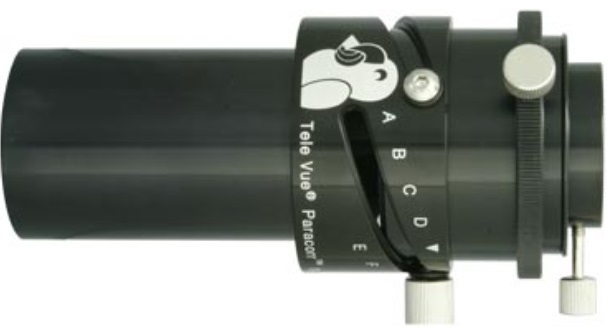 For many amateur astronomers around the world with fast Newtonian telescopes (including the author of this article), the coma corrector plus eyepiece combo has become a staple of their visual observations. Benefits of Coma Correcting EyepiecesUsing a coma corrector has several drawbacks. It's an expensive, bulky device (typically 140 mm long and weighing about 0.5 kg) that adds 4 or 5 glass elements to the optical chain, limits the field of view, and adds some complexity to the focusing - the eyepiece needs to be positioned close to a specific optimum position with respect to the corrector. Coma correcting eyepieces have the potential to provide a lighter, cheaper, more convenient solution that can optically outperform the combination of a standard eyepiece with a separate coma corrector. I delve into more details about how coma correcting eyepieces can truly deliver in a dedicated article about the Benefits of Coma Correcting Eyepieces for Newtonian Telescopes. Personally, observing with very large Newtonian telescopes, I would love to be able to get rid of the coma corrector and use straightforward eyepieces that deliver larger fields, are lighter, and provide a simpler focusing experience. The eyepieces not only work well on Newtonian telescopes, they would be fine on any telescope from f/8 on, and work very well from
f/10 on. In other words, most SCTs and long refractors would be well served by the coma correcting designs. For example, the 32 mm 81°
design with 45 mm field stop shown below would be wonderful to use in f/10 SCTs!
Designing Modern Coma Correcting EyepiecesI discussed the idea of modern coma correcting eyepieces on astronomy forums and got mostly negative reactions. The Pretoria eyepiece from the 1980s was cited as evidence that the approach was tried but did not work, and the current availability of coma correctors meant that the problem was "solved". I did not agree with this point of view. As an engineer who loves an optimization challenge, I set about to create some high quality coma correcting eyepiece designs that could compete with the very best eyepieces currently on the market. I wrote a dedicated eyepiece optimizing, ray tracing software to make this possible. The software optimizes the dimensions (spacing, curvature, thickness) and glass types of the elements to produce the best possible eyepiece. The software understands that the eyepiece quality is not just about tightness of the stars across the field, but also about the eye relief, distortion, curvature, length and diameter, weight and cost. You can read more details in the article about the Cruxis Eyepiece Designer. Some Coma Correcting Eyepiece DesignsBelow I present a selection of high-quality coma correcting eyepiece designs. With the Cruxis Eyepiece Designer it's easy to create these configurations, to scale them and automatically optimize them for some new focal length or field target. All the eyepieces presented below have been optimized with the following parameters:
They should compare favorably with the very best eyepieces for image quality, true field of view, comfort of use, and compactness. You can click on the images or on the links to get more details about their design and performance. 32 mm 81° Coma Correcting EyepieceProviding a 45 mm field stop with tight stars right to the edge, without distortion, this would be the ultimate wide-field eyepiece for a 2 inch focuser. It would provide a 25% larger field than the Televue Nagler 31 plus Paracorr combo the author is currently using on his 25" f/5 telescope, in a significantly lighter and more compact package. 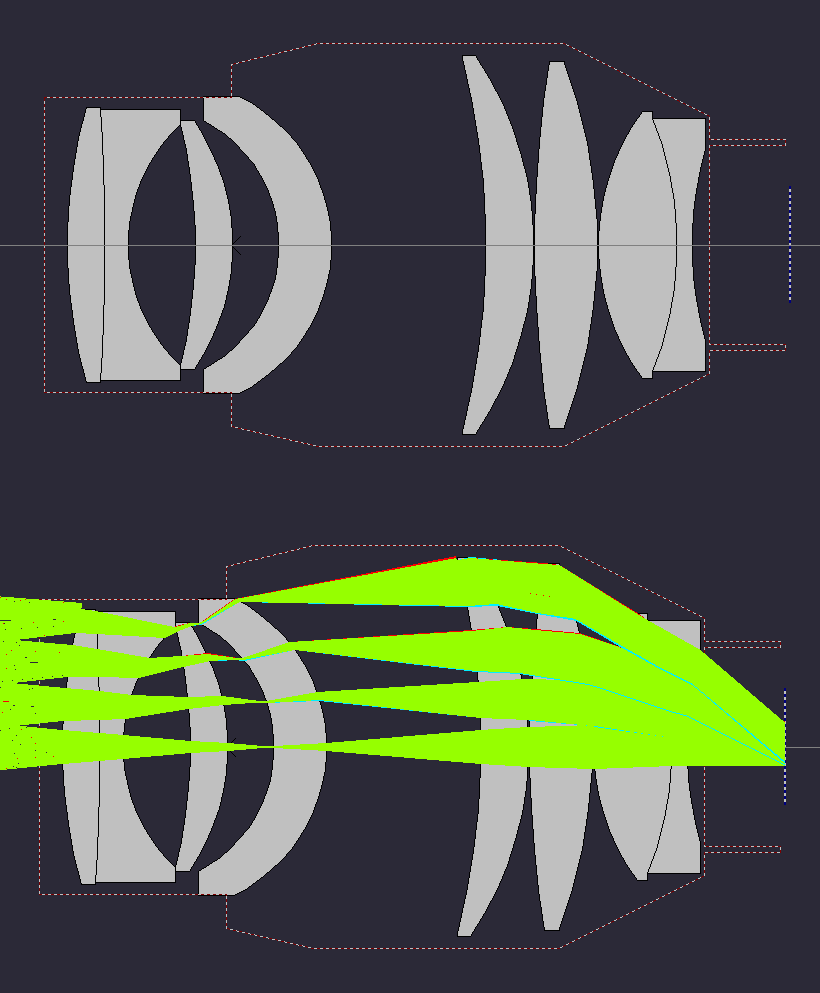 See 32 mm 81° coma correcting eyepiece with a 45 mm field stop, producing a significantly larger true field of view than the current solutions. 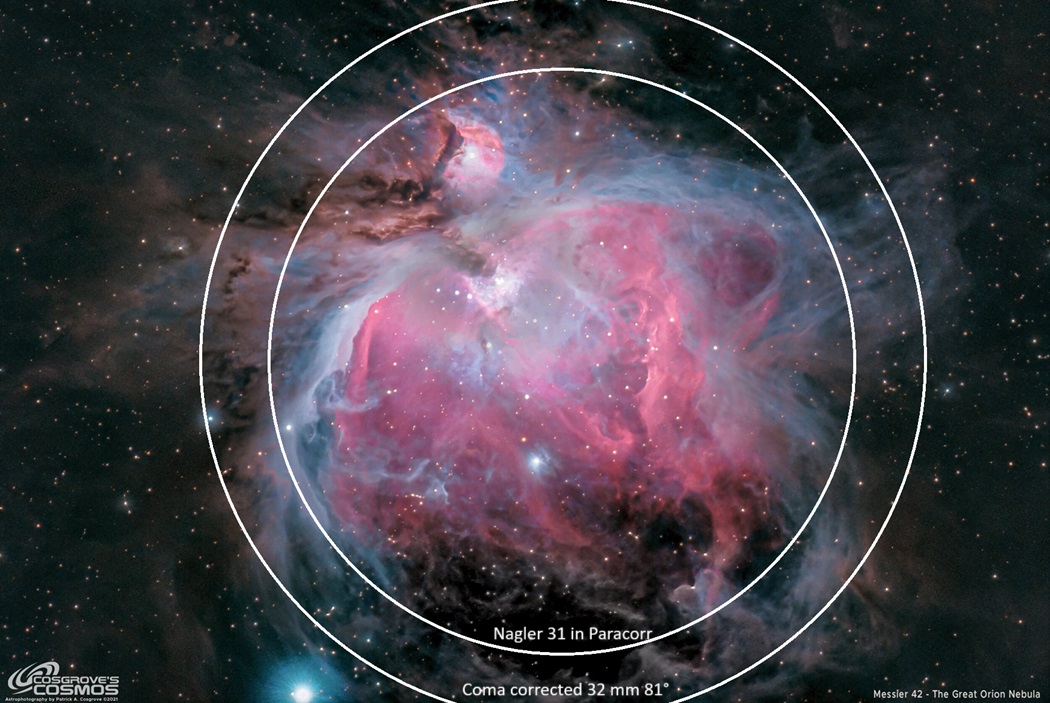 28 mm 86° Coma Correcting EyepieceProviding a 41.5 mm field stop with tight stars right to the edge, without distortion, this eyepiece would provide the maximum 7 mm exit pupil in f/4 Newtonian telescopes, like the original 28 mm Pretoria eyepiece (but with 86° instead of 50° apparent field of view!). 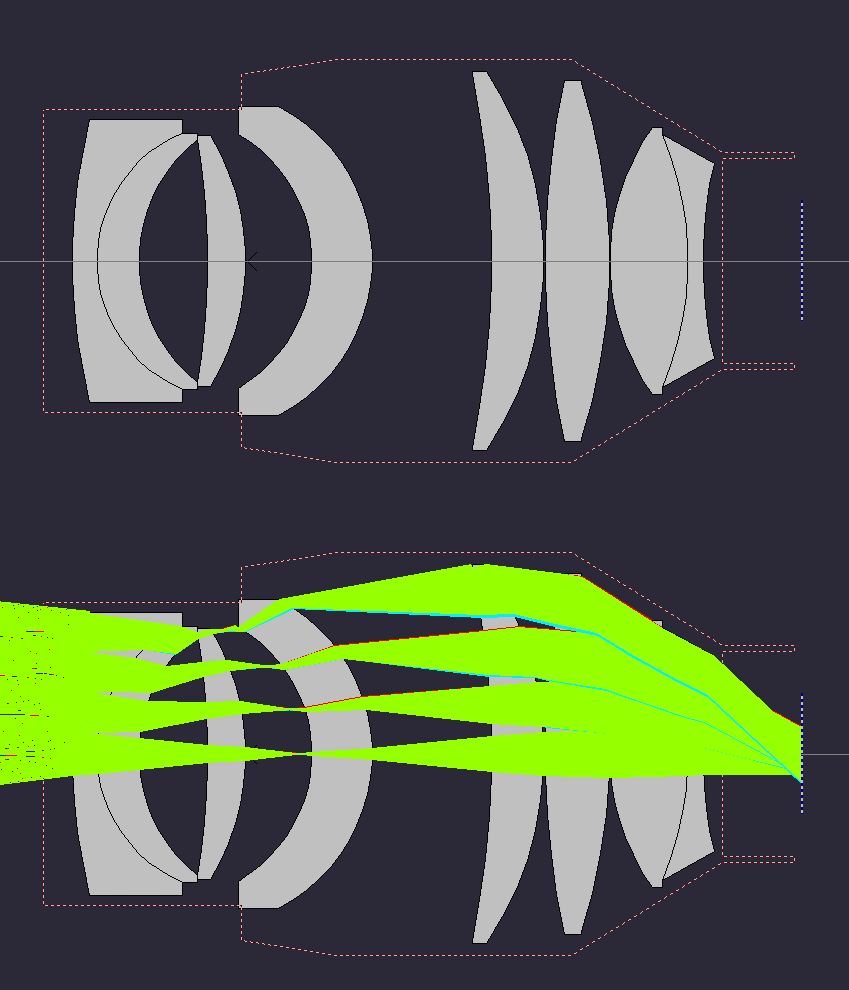 See 28 mm 86° coma correcting eyepiece with a 41.5 mm field stop in a compact package, illustrated by the following comparison between this design and the Paracorr + Nagler 31 combo that it would replace. 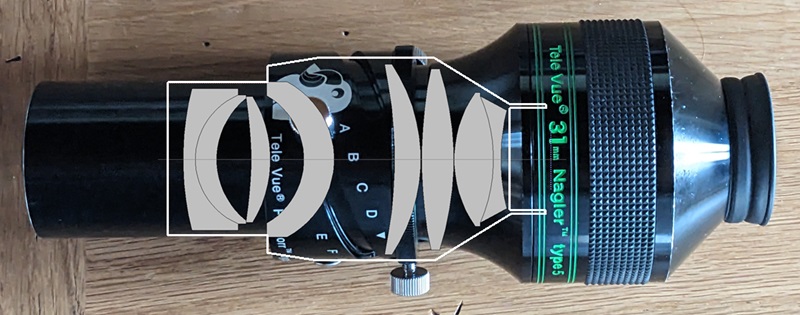 24 mm 86° Coma Correcting EyepieceProviding a 36 mm field stop with tight stars right to the edge, without distortion, this eyepiece would provide a 15% larger field than the Televue Ethos 21 plus Paracorr combo the author is currently using on his 1100 mm f/3.6 telescope, in a significantly lighter and more compact package. 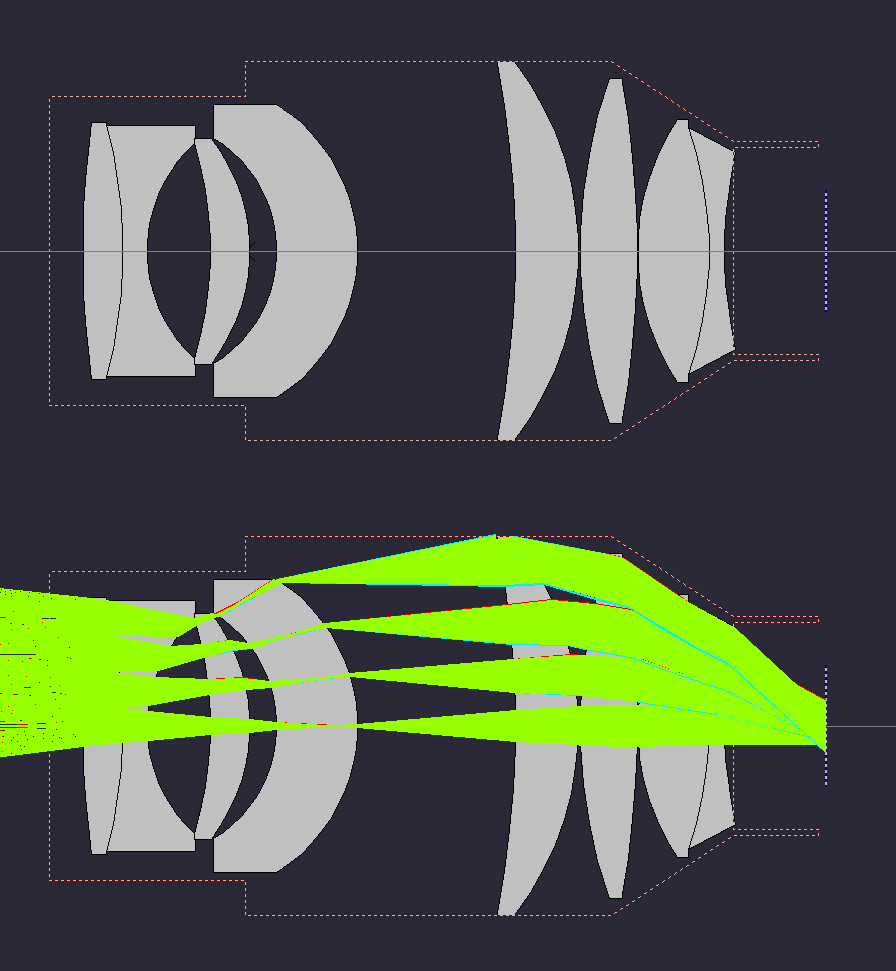 See 24 mm 86° coma correcting eyepiece with a 36 mm field stop. 20 mm 100° Coma Correcting EyepieceProviding a 35 mm field stop, this would be the ultimate wide-field eyepiece for very fast Newtonian telescopes. It would provide a 10% larger field than the Ethos 21 in Paracorr combo, in a lighter and more compact package. 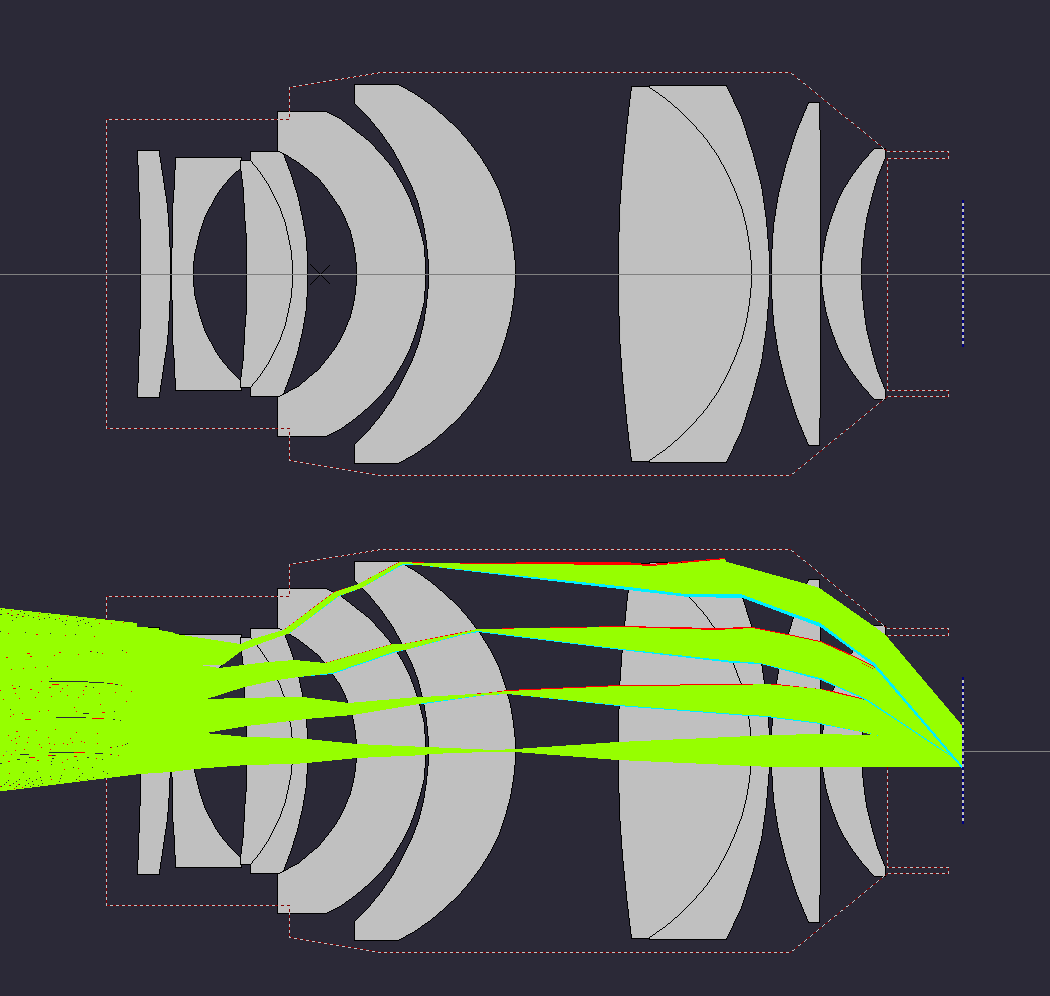 See 20 mm 100° coma correcting eyepiece with a 35 mm field stop. The 20 mm would provide more observing comfort because of its generous eye relief (17 to 20 mm). Below a comparison of the solutions: 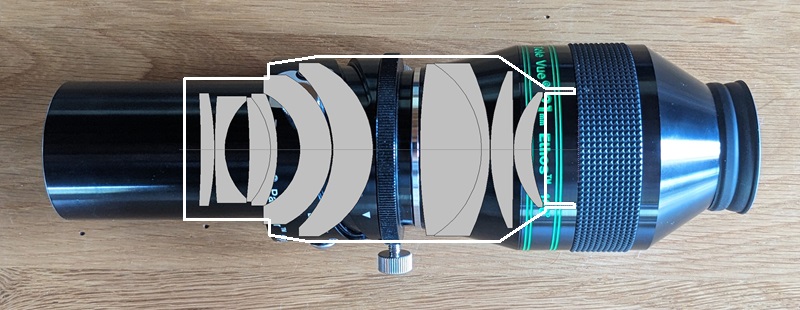 Closing thoughtsThe approach presented on this page makes most sense if you can get rid of the coma corrector altogether, and use only coma correcting eyepieces in your Newtonian telescope. This would be perfectly possible; I have been able to create a line of coma correcting eyepieces starting from 32 mm down to 6 mm with 86° or 100° field of view. There is some inevitable trade-off between compactness and cost versus large field of view and larger eye relief. 100° eyepieces are bulkier, more expensive and have lower eye relief. I feel that in many cases a 86° version is a good compromise between bulk and performance. Writing in Summer 2024, all this is just "design" and not "reality". I hope that someday it will be possible to manufacture some of these eyepieces; I'd really love to have my hands on any of the eyepieces listed above, they would be awesome performers! Clear Skies!
| ||||
|